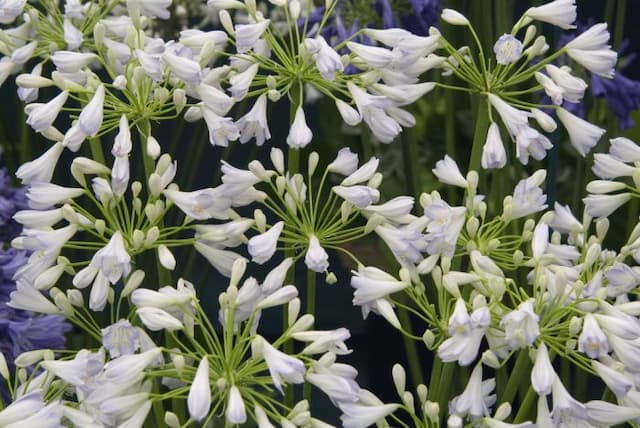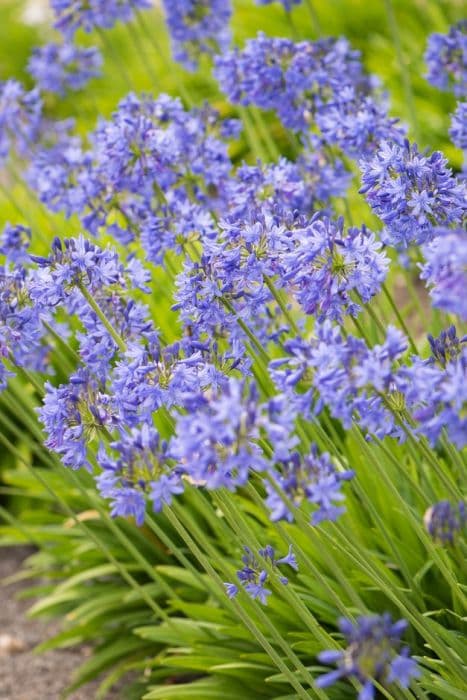African Lily Agapanthus 'Ice Blue Star'

ABOUT
Agapanthus 'Ice Blue Star' is a visually striking plant known for its unique and attractive blooms. The plant showcases a clump of lush, strap-like leaves that are a deep, rich green, providing a verdant backdrop for the delicate flowers it produces. These leaves often form a dense and arching foliage base from which the floral display emerges. The most eye-catching feature of the Agapanthus 'Ice Blue Star' is its floral arrangement. It produces rounded clusters of flowers called umbels, which consist of numerous small, trumpet-shaped flowers. These individual blooms are a pale blue hue with a subtle hint of ice blue, giving the impression of a cool, starry cluster. The flowers are perched atop tall, slender stalks that rise elegantly above the green foliage, creating a height contrast that adds to the overall beauty of the plant. During the blooming season, the numerous flower heads create a spectacular show that can be reminiscent of a fireworks display in terms of their shape and clustered appearance. The inflorescence of the Agapanthus 'Ice Blue Star' is not only a delight to look at but may also attract various pollinators, adding a lively dimension to its display. Overall, the Agapanthus 'Ice Blue Star' is known for its serene and cool-toned flowers, which can add a touch of elegance to garden spaces, borders, or even as container plantings, where the intricacies of its beautiful blooms can truly be appreciated up close.
About this plant
 Names
NamesFamily
Amaryllidaceae
Synonyms
African Lily, Lily of the Nile
Common names
Agapanthus 'Ice Blue Star'.
 Toxicity
ToxicityTo humans
The African Lily is generally considered to be of low toxicity to humans. However, it can cause mild stomach upset if ingested. Symptoms can include nausea, vomiting, and diarrhea. Parts of the plant, such as leaves and roots, contain saponins which can be mildly toxic when consumed in large quantities.
To pets
For pets, particularly cats and dogs, the African Lily is considered toxic. If ingested, it can cause gastrointestinal symptoms including nausea, vomiting, and diarrhea. There could also be drooling or signs of discomfort. If you suspect your pet has ingested any part of an African Lily, it is advisable to contact a veterinarian promptly.
 Characteristics
CharacteristicsLife cycle
Perennials
Foliage type
Evergreen
Color of leaves
Green
Flower color
Blue
Height
2 feet [60 cm]
Spread
2 feet [60 cm]
Plant type
Bulb
Hardiness zones
8
Native area
South Africa
Benefits
 General Benefits
General Benefits- Attractive Flowers: Agapanthus 'Ice Blue Star' features striking blue star-shaped blooms that add a vibrant touch to any garden or landscape.
- Drought Tolerance: This plant is relatively drought-tolerant, making it ideal for gardens in arid climates or for gardeners seeking water-wise plants.
- Low Maintenance: It requires minimal care once established, making it suitable for busy gardeners or those new to gardening.
- Long Blooming Period: It has a long flowering season, providing color and interest in the garden for an extended period.
- Attracts Wildlife: The blooms attract pollinators such as bees and butterflies, promoting biodiversity in the garden.
- Border Planting: The plant is excellent for borders or as a focal point due to its clumping habit and lush foliage.
- Container Gardening: Agapanthus is well-suited to container gardening, allowing those with limited space to enjoy its beauty.
- Resistant to Pests: It is generally resistant to pests and diseases, reducing the need for chemical treatments.
- Coastal Tolerant: The plant can tolerate coastal conditions, such as salt spray, making it an excellent choice for seaside gardens.
- Cut Flowers: The flowers are suitable for use in floral arrangements, providing an additional use beyond the garden aesthetic.
- Structural Interest: Agapanthus offers structural interest to the garden with its strap-like leaves and upright flower stalks even when not in bloom.
 Medical Properties
Medical PropertiesThis plant is not used for medical purposes.
 Air-purifying Qualities
Air-purifying QualitiesThis plant is not specifically known for air purifying qualities.
 Other Uses
Other Uses- As a natural dye: The flowers of the Agapanthus can be used to produce a blue dye for fabrics and crafts.
- In artistic inspiration: The striking appearance of the Agapanthus inspires artists and photographers, who use it as a subject in their work.
- As a decorative motif: The distinct shape of the Agapanthus flowers are used in designs for textiles, wallpaper, and other interior decorations.
- In clothing accessories: Dried parts of the Agapanthus, like seed heads, can be used to create unique and nature-inspired jewelry pieces or hair accessories.
- As a culinary decoration: Though not consumed, the flowers can decorate plates and platters for a touch of elegance in food presentation.
- In potpourri: Dried Agapanthus flowers can add visual appeal and a mild fragrance to homemade potpourri blends.
- For educational purposes: The Agapanthus plant can be used in horticultural courses to teach about plant structure, hybridization, and care.
- In floral photography backgrounds: The dense clusters of Agapanthus blooms make for an attractive, textured backdrop in close-up photography.
- As a natural confetti: The small blossoms can serve as biodegradable confetti for outdoor celebrations.
- In float decoration: With their vibrant colors and large clusters, Agapanthus can be used to create stunning displays on floats for parades or festivals.
Interesting Facts
 Feng Shui
Feng ShuiThe African Lily is not used in Feng Shui practice.
 Zodiac Sign Compitability
Zodiac Sign CompitabilityThe African Lily is not used in astrology practice.
 Plant Symbolism
Plant Symbolism- Love Letters: The name "Agapanthus" is derived from the Greek words 'agape' meaning love, and 'anthos' meaning flower. Together, they symbolize love letters or a message of love, making the 'Ice Blue Star' variety a symbol typically associated with enduring love and affection.
- Beauty: With its striking blue to violet flowers, the Agapanthus often symbolizes beauty and a unique presence, resonating with the natural attractiveness and impressive bloom of the 'Ice Blue Star'.
- Fertility: In some cultures, Agapanthus blooms are associated with fertility due to their lush and plentiful blossoms.
- Endurance: The Agapanthus plant is hardy and can grow in difficult conditions, symbolizing endurance and the ability to withstand challenges, mirrored in the 'Ice Blue Star' cultivar's resilience.
- Freedom: The long, slender stems of the Agapanthus can sway freely in the breeze, which is sometimes interpreted as symbolizing freedom or the spirit of liberty.
 Water
WaterThe Lily of the Nile should be watered deeply until the water runs through the drainage holes, and then allowed to dry out somewhat between waterings. In general, the plant might require watering approximately once a week during the active growing season, but this can vary greatly depending on climate and soil conditions. Aim to provide about one to two gallons per watering session for a large plant or less for smaller plants, making sure not to waterlog the soil. During the winter months or dormant periods, reduce watering frequency to every few weeks or when the top inch of soil feels dry.
 Light
LightLily of the Nile prefers full sun to partial shade, with a minimum of six hours of direct sunlight per day to thrive and bloom effectively. The best spot for the plant would be in a location where it can receive morning sunlight and partial afternoon shade, especially in hotter climates, to protect it from the intense heat of the day.
 Temperature
TemperatureLily of the Nile can tolerate a range of temperatures, but the plant enjoys moderate conditions and performs best between 60°F and 80°F. It can survive minimum temperatures down to about 50°F, but sustained cold below this point can damage the plant. Ideal temperature conditions include warm days and slightly cooler nights.
 Pruning
PruningLily of the Nile should be pruned to remove spent flower stems and to tidy up the plant's appearance, which encourages new growth and additional blooms. Pruning is typically done after the plant has finished flowering in late summer or fall. Dead or damaged leaves should also be removed to keep the plant healthy. The best time for pruning is when new growth begins to appear, once the threat of frost has passed.
 Cleaning
CleaningAs needed
 Soil
SoilLily of the Nile prefers well-draining soil with a pH of around 6.0 to 8.0. A soil mix rich in organic matter such as peat, loam, and compost with added perlite or pumice for improved drainage will encourage healthy growth. Regular feeding with a balanced fertilizer during the growing season will benefit the plant.
 Repotting
RepottingLily of the Nile should be repotted every 2-3 years or when the root system outgrows the pot. It's best to repot in spring, before the onset of the growing season, using fresh soil to replenish nutrients.
 Humidity & Misting
Humidity & MistingLily of the Nile thrives in average room humidity conditions. This plant is not particularly humidity-sensitive but benefits from air circulation, avoiding the extremes of overly dry or overly humid environments.
 Suitable locations
Suitable locationsIndoor
Place Lily of the Nile in bright indirect light with good air circulation.
Outdoor
Plant Lily of the Nile in full sun to partial shade and shelter from harsh winds.
Hardiness zone
8-11 USDA
 Life cycle
Life cycleThe Agapanthus 'Ice Blue Star' or Lily of the Nile begins its life cycle as a seed, which when sown and given the right conditions, will germinate and develop a primary root and shoot. As the seedling grows, it establishes a clump of strap-like leaves and a strong root system. Over time, the plant enters its vegetative stage, producing more foliage and expanding its root network. As it matures, it enters the flowering stage, typically in late spring or summer, producing tall stems topped with clusters of blue or white star-shaped flowers. After pollination, these flowers may develop into seed pods if not deadheaded, completing the reproductive cycle. The plant then enters a period of dormancy in the cooler months, conserving energy before resprouting in the following growing season.
 Propogation
PropogationPropogation time
Spring-summer
The most popular method of propagating the Agapanthus 'Ice Blue Star', or "Lily of the Nile", is by division. This is typically done in the spring or early fall. To propagate by division, carefully dig up the clump of the plant, ensuring a good portion of the root system is intact. Using a sharp knife or spade, divide the clump into smaller sections, each with at least one or two growing points or shoots. Replant these divisions immediately at the same soil level they were previously, spacing them at least 12 to 18 inches apart (approx. 30 to 45 centimeters). Water the new plantings thoroughly to encourage root establishment. Division is a straightforward and effective way to create new plants that will be identical to the parent and can lead to blooms within the following growing season or two.








![African lily [Brilliant Blue]](/_next/image?url=https%3A%2F%2Fplants-admin.emdemapps.com%2Fimages%2Fplants%2F%2Fimages%2F604b5e3c28e2b.png&w=640&q=75)
